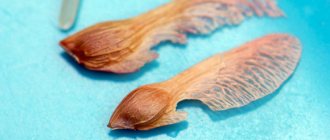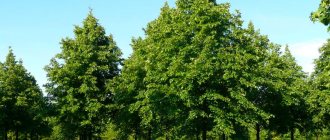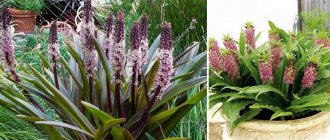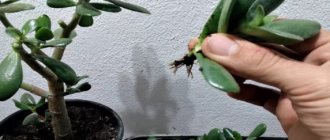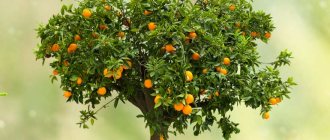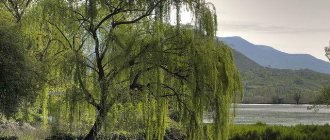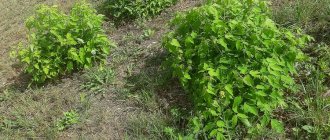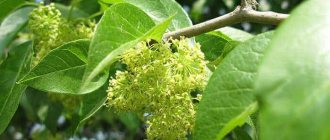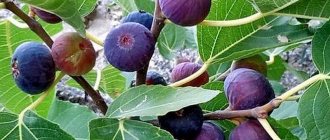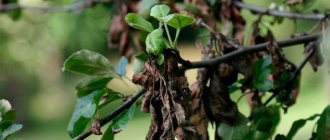General information, places of growth
Linden (Tilia).
The first information about linden as a subject of study is found already in 370-285. BC e. The Greek name for linden, according to Stromberg, means “tree loved by bees” or “tree that attracts swarms of bees.” And the botanical name of linden comes from the Greek word ptilon (wing) after the wing-shaped bract attached to the inflorescence. Carl Linnaeus in 1753 divided the genus Linden into two independent species: European linden and American linden. In 1763, the English botanist Miller first described an independent species of linden, and the German botanist Earhart gave it a little later the name - small-leaved linden. In the linden family there are up to forty genera, uniting about 500 plant species, distributed on all continents of the globe, but mainly in the tropical countries of Southeast Asia, tropical Africa, and Brazil. The genus Linden includes up to 45 species of linden, found in the temperate and partially subtropical climate of the Northern Hemisphere.
In Russia, 16 species of linden grow and 11 exotics have been introduced. In Ukraine and Moldova you can find European, large-leaved, tomentose, or Hungarian (silver) lindens, and in the Caucasus and Crimea - Caucasian linden, or Crimean, pubescent columnar, Ledebura. In some areas of the European part, American or black linden is cultivated; abandoned, variegated - all native to North America. In the Far East, linden is also not uncommon: Amur, Komarova, spreading, Take, Manchurian, Korean, Chinese, and Olivera lindens are common there.
Significant contributions to the diverse study of the linden genus were made by travelers and many scientists, mainly foresters and botanists. Most Russian and foreign authors recognize the very significant study of linden in Russian conditions. At the same time, emphasizing that the methods of studying and systematizing the linden genus by Russian scientists are more reliable than the corresponding data of foreign authors.
In terms of habitat, linden belongs to both forest species and trees cultivated artificially on city streets, along roads and alleys, in squares and parks, around fields, gardens, apiaries and ponds, in various hedges.
The small-leaved linden, which has a very similar species in Western Siberia - the Siberian linden, is distinguished by its greatest popularity, more significant economic significance and very wide natural range compared to other species.
Types and varieties
There are about 45 species and over 100 hybrid varieties of linden. The most common: heart-shaped linden or small-leaved linden, large-leaved linden, Amur linden, felt linden or downy linden, Siberian linden, European linden, bush linden.
American (black)
American linden
American linden or black linden is a heat-loving tree up to 40 meters high. The crown is wide, oval, the bark is inky black. The leaves are oval-shaped, wide, up to 20 cm long, heart-shaped at the base, with notches along the edges. The flowers are large, collected in drooping inflorescences of 6-15 pieces, up to 1.5 cm in diameter. Representatives of this species grow rather slowly.
Amurskaya
Amur linden
Amur linden is a graceful tree up to 30 meters high. The crown is dense, compact, oval in shape. The bark of young plants is glossy, brownish-purple, while in adults it is dark smoky, with longitudinal cracks. The leaves are shaped like a heart, with grooves along the edges, up to 7 cm long. Fragrant flowers of a milky or lemon shade are collected in inflorescences of 5-15 pieces.
Yellowing "Glenleven"
Linden yellowing
Yellowing linden is an ornamental tree up to 15 meters high, with a wide pyramidal crown. The bark is rough, smoky in color. The leaves are large, rounded, heart-shaped, olive-colored, with dark veins and a purple-gold “spraying” on top. In autumn, the leaves take on a straw color. Representatives of this species bloom profusely, with fragrant golden flowers. Linden grows quite quickly and prefers dry, well-drained soils. The tree loves sunlight, but can tolerate light partial shade.
To maintain the crown of the yellowing linden in a picturesque condition, it is recommended to prune it at least once every five years.
Felt (silver) or Fluffy
Felt linden
Felt linden or downy linden is a stately tree up to 30 m high. The crown is regular in shape, broadly pyramidal or oval. Silver linden has the main distinctive feature: the leaves of the tree are round, up to 12 cm long, with sharp, unevenly serrated edges, dark olive on top, covered with light fluff at the beginning of development, and white on the underside, covered with villi. In bright sunlight, the edges of the leaf curl slightly, revealing a silvery underside, creating an original contrast of dark green and silver sheen. Closer to autumn, the leaves turn yellow and remain on the tree until winter.
European
Linden
The European linden is a tree up to 40 meters high, the crown of which is wide oval in shape. The leaves are round, with a heart-shaped base. Representatives of this species grow quite quickly.
Caucasian
Caucasian linden
Caucasian linden is a tree up to 40 meters high, with a round or wide ovoid crown. Young shoots of Caucasian linden are purple-red. The leaves are large (up to 14 cm long), wide, oval. The upper side of the leaves is dark green, the back side is dark gray, with tufts of whitish hairs near the veins. Drooping inflorescences with light yellow flowers. Flowering is abundant.
https://youtu.be/JVlLpRyGVCA
Large-leaved or flat-leaved
Large-leaved linden
Large-leaved linden (planophylla linden) is a tree up to 35 meters high and up to 20 meters wide. The crown of the large-leaved linden is initially conical or wide, ovoid, later rounded. The main branches are vertical, the side shoots are horizontal. Broadleaf linden has large leaves that bloom 14 days later than small-leaved linden, but it pleases with flowering two weeks earlier. The flowers are lemon-milky, collected in inflorescences of 2-5 pieces.
Manchurian
Manchurian linden
Manchurian linden is a tree up to 20 meters high. The crown is regular in shape, round. Representatives of this species are similar to specimens of the Amur linden, but differ in larger leaves and flowers. The flowering is beautiful and abundant.
Small-leaved (heart-shaped)
small-leaved linden
Small-leaved or heart-shaped linden (tilia cordata) is a tree up to 30 meters high and up to 15 meters wide. Small-leaved linden has synonymous names: lutoshka, bastweed, lubnyak. The crown of the tree is initially conical, later ovoid. The main branches grow diagonally or vertically, the side shoots bend and hang down at the bottom of the crown.
The heart-shaped linden has glossy green leaves, dark gray on the back, with a serrated edge. In autumn, the cordifolia linden delights the eye with beautiful light lemon leaves. Young branches of representatives of the species are covered with satin bark, while old ones are covered with deeply cracked bark of a smoky gray color. The flowers are fragrant, with bracts, light straw color, collected in semi-umbrellas. The fruit is a nut with one seed. It blooms in July, the fruits ripen in October. One of the common varieties of this species, bred specifically for urban landscaping, is the small-leaved linden variety Greenspire.
An advantageous feature of the Greenspire variety is that representatives of the variety grow two times less in height than the species small-leaved linden. They have a more compact and dense crown and better tolerate low air and soil humidity.
Ordinary
Linden
The common linden is an elegant tree up to 40 meters high, a natural hybrid of the small-leaved linden and the large-leaved linden. The crown of the tree is wide, shaped like a pyramid. The flowering time begins in July.
Siberian
Siberian linden
Siberian linden is a tree up to 25 meters high. The bark of old trunks is dark and cracked. Young shoots are dark purple or brown-amber, glabrous, with small rounded lentils. The tree blooms in the second half of July, flowering lasts two weeks. Linden honey is light, almost white, with a delicate aroma of linden flowers, of excellent quality. Belongs to the best varieties. It differs from others in its late flowering and high winter hardiness.
Japanese
Japanese linden
Japanese linden is a tree up to 20 meters high. It grows in East Asia, in deciduous subtropical forests. Young bark is smooth, brown, old bark is furrowed, dark. The crown is located high, compact, oval in shape. The leaves are small, 5-7 cm, oval, olive on the outside, gray on the inside, with hairs at the corners of the veins. Flowering occurs in July or August for 14 days. The flowers are tiny, collected in large numbers in drooping inflorescences. The fruits, which ripen by September, are round, smooth, downy nuts. Representatives of this species grow rather slowly. The species is frost-resistant and is an exclusively honey-bearing plant. Japanese linden tea has proven itself as a flavored green tea.
Long-lived
Linden is a very durable tree, usually living up to 400-600 years, and sometimes up to 1100-1200. For example, in Nuremberg there are trees dating back seven to eight centuries. In Kyiv, near the Church of the Tithes, a giant tree, whose age is close to a thousand years, is still preserved. On the streets of large cities, linden lives for about 80-100 years. However, this is not considered the limit, since in different cities there are known linden plantations that are more than 300 years old. The life expectancy of linden in Western Siberia does not exceed 300 years. Trees growing in the first tier with a small crown density are distinguished by the greatest durability. In the second tier, linden lives up to 100 years, and in the undergrowth - up to 25.
Small-leaved linden (Tilia cordata) is a tree of the first size, reaching a height of more than 30 m and more than 1 m in diameter. In unfavorable growing conditions, especially under a dense canopy of plantings, it is found in the form of an undergrowth shrub (for example, in pine forests) or in the second tier (in sandy loam subbords).
Small-leaved linden, growing in various forest growth zones, is characterized by polymorphism. Under certain environmental conditions and general properties, this species is characterized by individual variability and the identification of ecological forms. The natural range of small-leaved linden is quite wide compared to other types of linden, which are found less frequently and mainly in the form of artificial plantings. It covers a vast territory of Europe and part of Asia. However, the distribution of linden is very uneven and depends on the diversity of natural conditions and human activities. Small-leaved linden naturally grows in the south, west and southeast of England, Norway, Sweden, Finland, the northeastern part of Iran, northern Italy, Spain, and along the Carpathian islands. In our country, small-leaved linden grows in ravine oak groves of the steppe, in oak groves and pine forests of forest-steppe, in the zone of coniferous-deciduous forests, and partly in the taiga zone (southern and middle taiga). Occasionally, small-leaved linden can be found in the Crimea and the Caucasus, where it rises into the mountains up to 1800 m above sea level. In Siberia it is found in islands almost to the Irtysh. In Altai there is the Siberian linden. And in the Far East, small-leaved linden is replaced by Manchurian and Amur.
Linden, bark
In closed forest stands, linden trees have a relatively straight, thin, highly branched trunk with a highly raised, usually not very dense crown. In a relatively free state, the linden crown is dense and raised low. Its lower branches extend downwards from the trunk and rise at their tops. The middle branches extend from the trunk horizontally, and the upper ones at an upward angle. With such branching, its shoots are densely covered with dark green foliage with hanging semi-umbrellas of yellow-white flowers with yellow-green bracts, forming a tent-shaped, very decorative crown. When free, the trunk is covered almost to the base with branches. The crown reaches full development by the age of 40.
The bark of the linden trunk in youth is smooth, but in old age it becomes thick, deeply furrowed, with longitudinal cracks, dark gray in color, with a strongly pronounced crust.
Linden propagation: methods
If you use linden seeds when propagating a tree, the pictures of which suggest the laboriousness of the process, you can waste a lot of time. Not all seeds will remain viable, and given the long dormant period, seedlings can wait more than a year.
Read also: Interesting facts about apples, history, varieties, beneficial properties
It is most rational to use linden root shoots or layering as planting material. When rooting layering, the lower side shoots should be bent to the ground and secured by sprinkling it with it.
Linden buds
The ovoid-shaped buds are arranged in two rows, smooth, reddish-brown in color, covered with two scales of unequal size. The length of the buds is 5-6 mm, width - 3-4 mm. They are dry on the outside. At rest, the bud has 5 leaves with stipules and two rudimentary leaves in the form of tubercles on the growth cone. Young leaves are densely hairy and folded in half along the midrib. Each leaf, located between two stipules, is covered with covering scales containing a mucous substance inside that protects the leaves from drying out and frost. Linden shoots are shiny reddish-brown in color, geniculate, covered with lentils.
Leaves
The leaves are simple, leathery, pointed, with a heart-shaped base, doubly and finely toothed at the edges, dark green glabrous above, and bluish-light green below with reddish hair beards in places where large veins branch. The petiole is 1-3 cm long with tomentose pubescence, bare and reddish by autumn. The arrangement of the leaves is regular. The leaf blade is asymmetrical. The densely leafy crown of the linden creates a large assimilation surface. With an average relative fullness of the first tier at the age of 100-120 years and an average diameter of 30-40 cm, there are up to 50 thousand leaf blades on one tree.
Linden leaves contain a huge amount of calcium, which promotes the rapid decomposition of litter without the formation of coarse humus, creating better physical properties of the soil and, ultimately, increasing its fertility. In one year of decomposition, the decrease in the dry mass of linden leaves from the original is 60%, i.e. significantly higher than that of hazel, elm, ash, birch and many other species. This decrease in leaf mass during decomposition occurs mainly during the spring-summer period, which is most favorable for the development of microorganisms and soil-litter invertebrate animals. Freshly fallen linden leaves contain about 10% ash, of which more than 3% is calcium. They are rich in potassium (about 1.3%), nitrogen (more than 1.9%), sulfur (0.5-1.0%).
Application of linden
- Linden seeds are quite nutritious and are consumed in the same way as walnuts and hazel. From them you can obtain oil that is close in quality to olive oil and in taste to almond oil.
- Fresh leaves of this tree are used to create salads, and dried leaves are added to dough.
- Linden blossom is also used instead of tea.
- People have long begun to use linden bark in their households. It is used to weave bast shoes, baskets, and baskets.
- Linden is an excellent honey plant.
- Linden wood is used as an ornamental tree, which was used by our ancestors.
Healing properties of linden
- Doctors of Ancient Rome and Greece used linden blossom to treat various diseases, and the sap of this tree helped to grow hair.
- The flowers of this tree are used for diseases of the bladder and kidneys, runny nose, cough, and bronchitis.
- Linden flowers are also used as an antipyretic and diaphoretic for sore throats and colds.
- Linden blossom is a famous disinfectant that is used as a gargle for inflammation of the throat and mouth.
- A decoction of linden leaves is necessary for pain in the urethra and stomach.
- Boiled young linden bark produces mucus, which has pronounced analgesic and anti-inflammatory properties. The mucus is used as a lotion for burns, inflammation of the hemorrhoid, and for rheumatism and gout.
Linden, roots
The root system of linden on loose and fertile soils is deep, powerful, well developed, has a deep taproot and highly developed lateral roots. Due to this, windblown trees are rare. In addition, the linden root system has a tiered structure, which allows it to use nutrients from all soil horizons and, most importantly, the underlying loam. When mixed with oak, its roots are located mainly in the upper horizons of the soil, making up the upper tier of the root system. Thanks to its depth and power, linden draws a large amount of ash elements from the underlying loam into the biological cycle, enriching the upper layers of the soil with them. Being plastic, the linden root system contributes to a more complete use by the plant of moisture and food elements contained in the soil layer. It also has a superficial root system, which is formed by lateral adventitious roots.
Linden fruits
Linden fruits are nut-shaped. They are light in color at first and then become dark in color. They are the size of a pea. They fall in a whole bunch at once. Each such cluster has a special leaf, which spins when it falls and helps the seeds fly as far as possible from the tree in order to give life to a new plant.
Linden, flowers
Linden flowers are bisexual, regular, 5-membered, small, in false umbels, collected in racemes; 5 sepals, 5-petalled corolla, 1 pistil, many stamens. The ovary is superior, 5-locular with two ovules in each ovule. In different conditions, small-leaved linden blooms in late June-early July, the average flowering time is 12-14 days. Linden of seed origin in plantations begins to bloom, as a rule, from 20-25 years or 5-10 years earlier than trees of coppice origin. With age, the number of flowers on a tree increases, and the sugar content in them changes slightly.
Flowering and nectar production in linden are determined by a number of geographical, climatic, biotic, ecological, edaphic, orographic, silvicultural-agrotechnical and many other specific features. The need to take them into account is explained by the fact that the linden tree begins to bloom when the bees have the opportunity to use its nectar most effectively.
Linden is a non-nectary plant. In its flowers, nectar is secreted by a special nectar-bearing tissue (the base of the petals of the calyx) and is held on the fleshy sepals on the inside. The nectar released in this way is not reabsorbed. To release nectar from such a “nectary” it is necessary that all parts of the plant are fully viable, elastic and contain a sufficient amount of water.
The linden tree reaches maturity at 20-30 years old and produces a large number of seeds almost every year. In open areas, fruiting begins at the age of 10, and in plantations - at 25 years and older, depending on the canopy density, and continues up to 200 years or more. Fruiting in older trees is rare and there are very few nuts on them. Linden seeds ripen in the fall and are collected from October throughout the winter.
The linden fruit is represented by 1-2 (less often 3)-seed nuts with 4-5 longitudinal, barely noticeable ribs. The shape is spherical or slightly elongated. A dense, water-impermeable shell covers the seeds. Without the shell, they contain more than 30% fat. Distribution of ripened linden seeds occurs with the help of the wind, especially over snow crust, or by animals (rodents) or birds. A distinctive feature of the seeds is low soil germination. Their germination rate is sharply reduced due to the fact that ripened seeds in the fall often remain hanging on the branches until the spring of next year, exposed to winter frosts.
Description of the plant
Linden trees are large deciduous trees up to 40 meters high. It’s nice to see what a linden tree looks like: a dense, beautiful, dense crown that can be easily molded, pleasing to the eye. Linden leaves are simple, alternate, heart-shaped, with notches along the edge, and pointed. In addition to the beautiful crown, linden has fragrant flowers, lemon-colored, collected in corymbose inflorescences.
Linden blooms for two weeks in July. The tree blooms in natural conditions at the 20th year of life, and in plantations - only after 30 years. During the time of linden blossom, the air is filled with a light, delicate honey aroma, which is felt far beyond the linden gardens and parks.
Linden fruits are single-seeded nuts. The seeds are tiny, the size of a pea. The fruits and nuts are collected several at a time on separate stems. Each such stem is equipped with a special wing, thin and quite wide. This wing helps the seeds disperse over long distances. It is easy to remember what a linden tree looks like; it can always be distinguished from other trees. In summer, along the heart-shaped leaves, in early spring, along the crimson young branches with buds, silky bark. The root system of trees is strong and deep.
Plants can reach a considerable age, but to the question: “How many years does a linden tree live?” there is no clear answer. There are linden trees that are up to 800 and even 1000 years old. In the forests where linden grows, other plants also thrive, since the falling leaves of lindens provide nutritious fertilizer. In addition, linden is a famous honey plant. Linden honey is considered one of the best.
Linden hardiness
Linden is a typically shade-tolerant species. In this it is second only to beech, spruce, fir, and hornbeam. Linden seedlings are considered especially shade-tolerant, growing successfully under the cover of broad grass, and even requiring shading in open areas. Moreover, it is shade-tolerant under the forest canopy and itself greatly shades the soil.
Small-leaved linden is classified as a frost- and cold-resistant species. It belongs to the group of broad-leaved species that accompany oak, penetrates farthest to the north and grows in harsh climatic conditions. It is not afraid of frosts, as it blooms late. The frost tolerance of linden is explained by the short period of shoot growth, the high water-holding capacity of the leaves and their low respiration rate, especially in the first half of the growing season, as well as the high oil content in young branches. Due to the fact that linden fats contain unsaturated linolenic acid, which can easily and quickly oxidize with the release of heat, linden tolerates frosts down to 48 degrees during winter dormancy.
Frost cracks on the trunks of linden trees growing in closed plantations are very rare. More often they are visible on the southern side of the trunk and on the branches of separately growing trees and, apparently, are associated with a sharp change in air temperature in the spring. In severe winters with little snow, frosting of annual linden shoots and roots is observed, especially at a young age. Frost resistance is greatly reduced when the suction and skeletal roots are pruned. In linden seedlings it decreases due to a decrease in soil moisture at the end of the growing season. Sometimes the reasons for the death of linden in landscaping, along with others, are the lack of insulation of the coma with a layer of snow and the drying out of the roots in the coma. Linden is extremely sensitive to frost and snow accumulation, especially in the undergrowth.
In areas with strong spring winds, young sticky trees sometimes die from drying out. Due to the presence of a small number of stomata in the leaves, linden easily tolerates droughts, and in very severe droughts it only reduces growth. In strong sunshine, it is able to combat the relative dryness of the climate with its mosaic arrangement of leaves, the outer row of which forms a kind of solid green ball, shading a large area with the root system.
Linden does not tolerate flooding. It can withstand channel and nearby lake-channel flooding with cool waters for 10-20 days.
Linden is considered a smoke-resistant species and does not tolerate air pollution by gases well. In shady groups, on fertile soils with good moisture, its gas resistance increases. At a young age, sensitive to fire. During ground fires and light continuous spring fires, young growth is damaged in clearings. It produces many new shoots. Frequent ground fires in the forest weaken the growth ability of linden trees.
Small-leaved linden is able to adapt and grow in a variety of soil conditions, except for swampy, saline and dry soils. It grows best in loose, fresh, humus-rich soils.
In the zone of podzolic soils, the presence of linden at least in the undergrowth indicates high soil fertility. In the forest-steppe zone, the participation of linden in the composition of plantings indicates leaching of soils and average productivity growing conditions. The participation of linden in the undergrowth of pine forests in the southern forest-steppe also characterizes highly productive conditions. This is explained by the fact that linden litter prevents the formation of coarse humus in coniferous plantations and increases their productivity even when the linden itself develops poorly. The litter formed from the litter of leaves, pine needles, branches, bark, etc., with linden, decomposes and forms neutral humus. This litter contains a minimum of ash elements, which helps neutralize humus acids, reduces the acidity of the soil solution, and increases the degree of soil saturation.
After cutting down a tree, growth from the stump, as a rule, appears around the neck of the root, and due to its strong shade tolerance, its thinning occurs very slowly. The property of the linden tree to produce abundant growth from the stump persists until old age. However, with age, this ability decreases, but remains quite high up to 100-110 years. It is no coincidence that all the logging areas of the linden farm are replanted with linden without changing the species. This plays an important role in the formation of modern linden forests.
After clear cutting, linden shoots densely populate the cutting area and drown out the self-seeding and undergrowth of conifers.
The natural regeneration of linden varies in different types of forest. The largest amount of linden regrowth, mainly coppice, is observed in oak-snow linden forests, in sorrel and pine oak forests, and comparatively less in ash oak forests.
Linden tolerates pruning well; its crown can be given any shape - ball, oval, cube and cone. No wonder the tree is considered the queen of parks and alleys.
Artists and poets pay tribute to her beauty. In our green spaces, the linden tree is revered no less than the Arabs – the palm tree, the Greeks – the olive tree, and the Hindus – the fig tree.
Planting and caring for linden
Landing
In nature, linden reproduces mainly by seeds. At the same time, in culture it is often propagated by layering, cuttings, root shoots or grafting. To create a dense hedge from such a tree, experts advise propagation by layering. In this case, the planting of grown seedlings should be carried out in waves, in a checkerboard pattern or in lines. Seedlings are planted in autumn or spring.
Before you start planting seedlings, you should prepare trenches or holes, the depth of which should be at least half a meter. A drainage layer is made at the bottom of the planting hole, which can be created using fragments of brick, crushed stone, sand or pebbles. The soil remaining from digging a hole or trench is combined with compost, humus, drill flour, a little sand and 40 grams of superphosphate per seedling are added. Fresh manure should never be used as fertilizer. In order to protect young plants from strong gusts of wind, pegs are installed during planting, which are necessary for gartering the trunk.
Care
Linden is distinguished by its moisture-loving nature; therefore, young trees growing in regions with arid climates are provided with regular watering. Those trees whose age is more than 5 years are resistant to drought and do not need watering. After the seedling is planted in a permanent place, during the first two years root fertilizing with nitrogen fertilizer should be carried out several times during the season. This promotes the growth of green mass.
Well-drained soil rich in nutrients is best suited for the plant. It responds well to the addition of lime to the soil, but its reaction to the accumulation of salts will be extremely negative. Mature trees can withstand frosts down to minus 48 degrees, and they are not harmed by climate fluctuations. The root system grows in breadth and depth. It is sensitive to tightness under conditions of dense planting.
The first time a linden tree is pruned is in the third year of life. As a rule, the side branches are shortened by a third of the length. This is necessary to form a crown with pronounced axial symmetry. Once a tree is 20–30 years old, it is considered mature.
Linden. Linden tree care. Features of linden propagation
